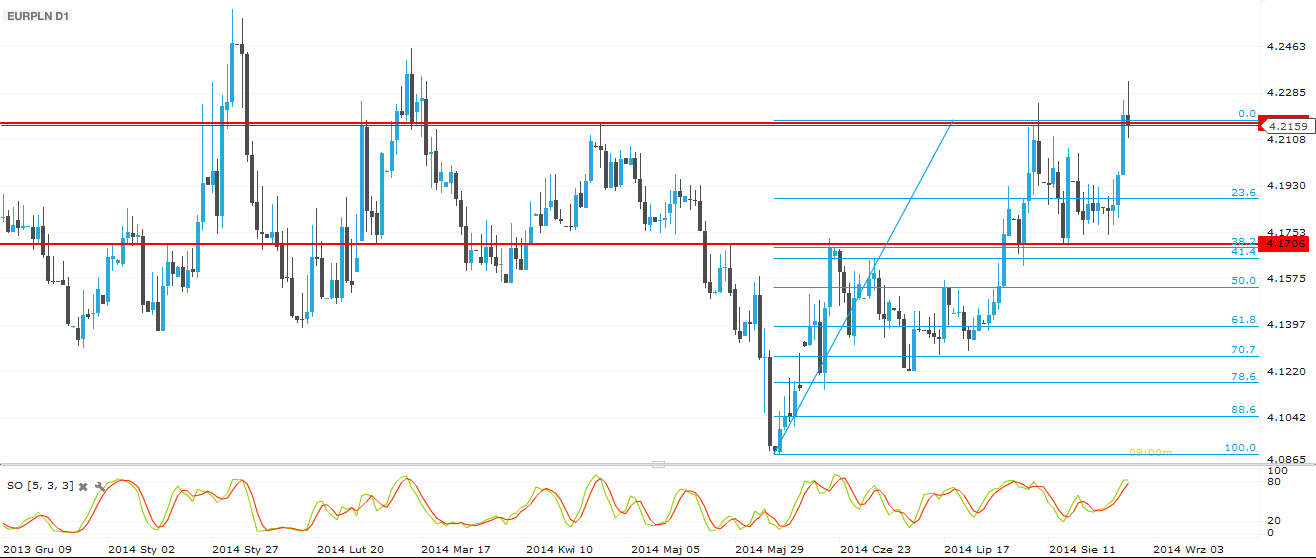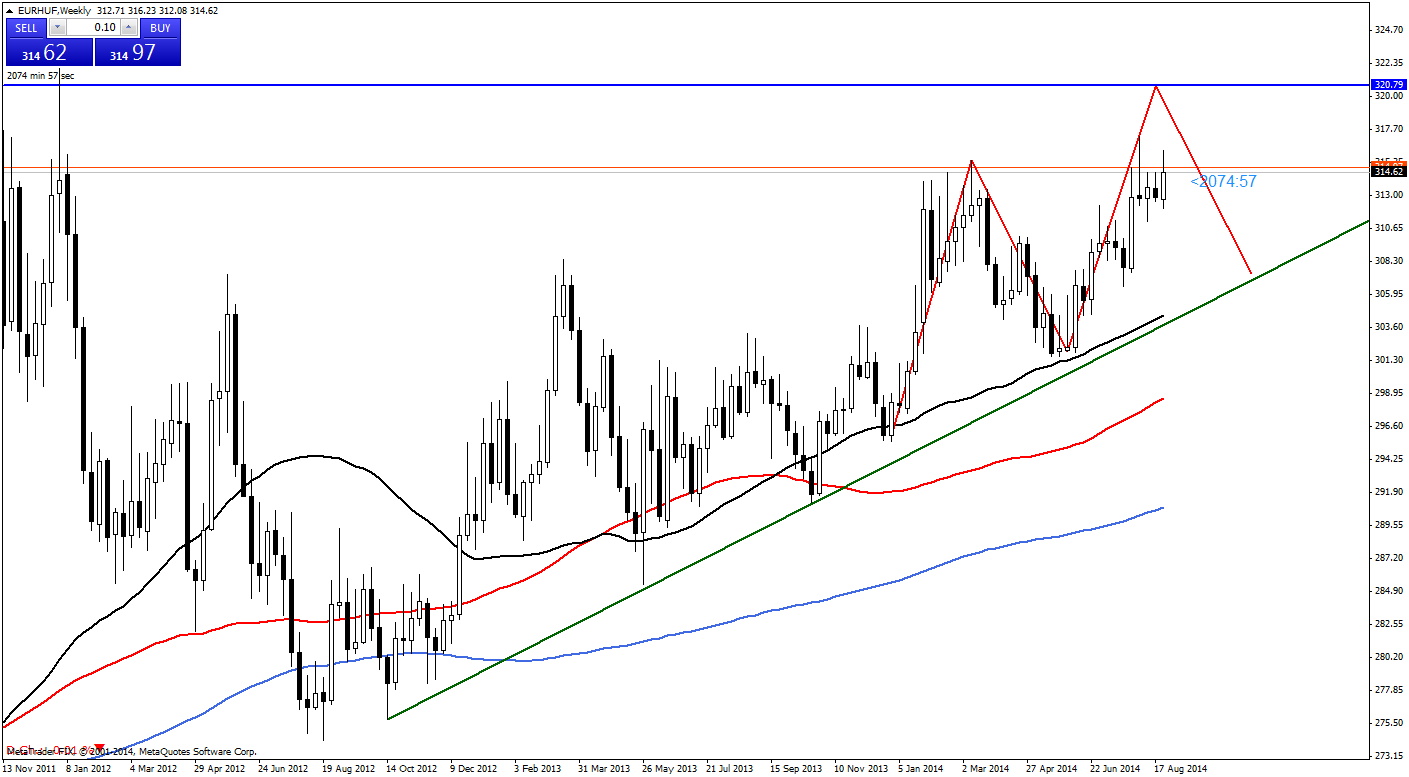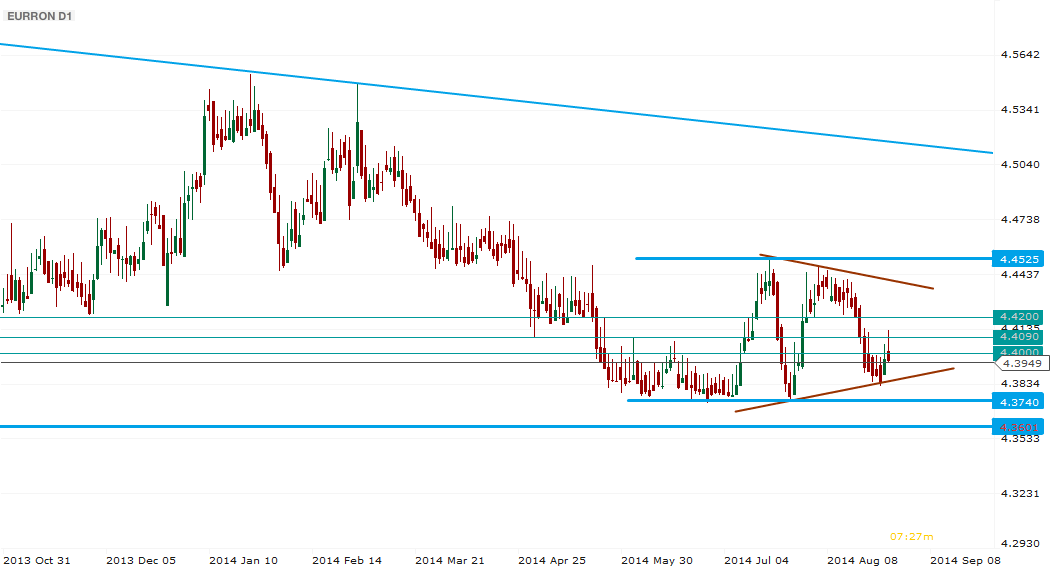Most analyst blame the Russia-Ukraine conflict for the major depreciation of emerging markets currencies. Partially, they are right. We have to remember though the negative effects of the slow growth of the Eurozone. Also, local factors start making their impact. In Poland growth slowed down and last month deflation was experienced. That is not the major danger though. As Marek Belka, MPC Governor, pointed out, a bigger threat comes from the possible Zloty appreciation when the Russia-Ukraine conflicts gets resolved. The Polish economy requires a weaker Zloty now, which was also mentioned by Mateusz Szczurek, Minister of Finance. At the same time, the Ministry of Finance will lower the forecast for GDP growth for 2015 – from the previous 3,8% to 3,4%. Average yearly inflation is expected to stay in a 1,0 - 1,4% range. What is worth mentioning, Szczurek mentioned the government has excess Euros, which can be liquidated. Issuance of Euro-denominated Treasuries is expected to halt this year as the MF wants to keep a 30% weight of foreign debt in total debt. So as we can see there are actors that can either strengthen or weaken the Zloty. Which of them will be deciding?
As we see on the daily chart, after trading close to the support of 4.17, the EUR/PLN shoot up and is testing the resistance at 4.2150. This week it reached even 4.23, but a further upward move can be expected if the closing price of this week will be above the esistance. Then, the market could attack 4.25, the highs from January of this year. A corrective movement could bring the EUR/PLN down to the first support at 4.2050 and if this is broken, then 4.17 could be the target.

Pic.1 EUR/PLN D1 Chart
Hungarian Forint (EUR/HUF) – testing the 315 resistance
This past week the EUR/HUF was stocked in a narrow range, but on Thursday it was shocked again. Emerging markets broke again because of the Russian supposed invasion. From what we have heard, Russian forces crossed the border and started providing armed assistance to separatists. Moscow denies but what the market react to, are the news. On Thursday night, NATO has published satellite images, which prove that the Russian troops in Ukraine carry out military operations. Putin asked the separatists to "open a humanitarian corridor" to let the Ukrainian forces leave the battlefield. The Ukrainian government will give a deliberate answer, because without Russian gas they cannot get through the upcoming winter - they can just hope for international assistance. Western states are considering additional economic sanctions, but so far those were only words. Obama and Merkel are on the same page when talking about the conflict. Other EU countries and Hungary experience to feel the bad effects of the "secret war". The low efficiency of Eurozone's economy also affects the Hungarian economy and
its currency. Still, macro data from the economy is not bad and the main reason causing the Forint to depreciate is the Russia-Ukraine conflict.
Just to note, Neil Shearing, the chief economist of Capital Economics said that regional currencies still have space to get stronger - in 2015 the EUR/HUF can be under the 300 level. If the conflict in Eastern Europe escalates, a huge selling wave can unfold and weaken the merging markets currencies. Currently, the EUR/HUF is fighting at the 315 resistance level. Breaking it would mean the market will target 317 next week. The closest support to which the market can decline, remains at 312.

Pic.2 EUR/HUF W1 Chart
Romanian Leu (EUR/RON) – Rangebound, for now, with some risks lurking
For the Leu the 4.40 area appears to be the new balance line, barring some out-of-the-ordinary developments in Ukraine. Some good news on the unemployment front – the rate fell to 7% in July – were prevented from swaying the markets by the regional worries and the somewhat shocking return to recession in Q2 to gain points for the local currency. We may easily assume that the National Bank is comfortable with levels at or above 4.40, but would much rather see EUR/RON above 4.45. The playground for next week seems to be, given the Ukraine situation, more or less above 4.40 but below 4.45.
The technical image paints a symmetrical triangle in the making. A clear breakout below is less likely, in our view, than one above, but only time will tell. For now the support stays at 4.3850, the lower bound of the triangle then at 4.36 and 4.34. Resistance is nearest at 4.4090, followed by 4.4200 and then 4.44 as the upper border of the triangle. Any push above 4.45 would be a clear sign the market still has about 600 pips (the width of the pattern) to go.

Pic. 3 EUR/RON D1 Chart
Recommended Content
Editors’ Picks
EUR/USD extends gains above 1.0700, focus on key US data

EUR/USD meets fresh demand and rises toward 1.0750 in the European session on Thursday. Renewed US Dollar weakness offsets the risk-off market environment, supporting the pair ahead of the key US GDP and PCE inflation data.
USD/JPY keeps pushing higher, eyes 156.00 ahead of US GDP data

USD/JPY keeps breaking into its highest chart territory since June of 1990 early Thursday, recapturing 155.50 for the first time in 34 years as the Japanese Yen remains vulnerable, despite looming intervention risks. The focus shifts to Thursday's US GDP report and the BoJ decision on Friday.
Gold closes below key $2,318 support, US GDP holds the key

Gold price is breathing a sigh of relief early Thursday after testing offers near $2,315 once again. Broad risk-aversion seems to be helping Gold find a floor, as traders refrain from placing any fresh directional bets on the bright metal ahead of the preliminary reading of the US first-quarter GDP due later on Thursday.
Injective price weakness persists despite over 5.9 million INJ tokens burned

Injective price is trading with a bearish bias, stuck in the lower section of the market range. The bearish outlook abounds despite the network's deflationary efforts to pump the price.
US Q1 GDP Preview: Economic growth set to remain firm in, albeit easing from Q4

The United States Gross Domestic Product (GDP) is seen expanding at an annualized rate of 2.5% in Q1. The current resilience of the US economy bolsters the case for a soft landing.